Use your widget sidebars in the admin Design tab to change this little blurb here. Add the text widget to the Blurb Sidebar!
Posted: July 18th, 2010 | Author: jihoi.lee | Filed under: architecture, project, Uncategorized | Tags: architecture, Emergency, Guro, Guro Digital Complex, Guro Industrial Complex, Jihoi Lee, stairs | No Comments »
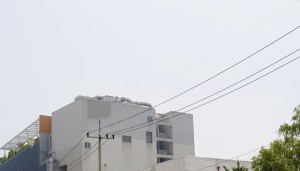
Recently I moved into a factory called Seoul Art Space_Geumcheon (they call it ê¸ˆì²œì˜ˆìˆ ê³µìž¥ in Korean, literally translated as Geumcheon Art Factory). It is an artist residency program located in Guro area – an aggregation of factories for heavy industries, which was part of the governmental urban planning during the 70′s. In the light of the IT industry, they started to call the Guro Industrial Complex to Guro Digital Complex and many visible shifts of the landscape began to ensue e.g. new skyscrapers, shopping malls, etc. Regardless of the struggles to refresh the atmosphere of the region by renaming it, reshaping it and even reprograming it in the name of Arts (like my residency space), the area doesn’t seem to easily get away from the impression of the Industrial region with poor factory workers.
There is an interesting anecdote I came across in the Postcapital lecture series at Total Museum, that this area had a very close relationship with rice price during the 70′s. Under the Park Chung-hee administration, the government hold the price of rice in order to shift the country’s major investment from the agriculture to Fordist industry. This led many farmers in bankruptcy, thus they naturally moved to Seoul especially to Guro to find a job in the newly opened factories. The unchanging rice price gave them a downside of losing their farms in the countryside, but also gave them an upside of surviving with the low wage they were getting from the factories. Some says that the government captured two rabbits – a Korean expression that means to say, in this perticular context, that they succeeded in both industrial shift and procuring the labour force who could work with unreasonable remuneration.
So here they are, some backdrop stories for one of projects that I’m working on at the moment in relation to the place that I became a resident of. While wandering around the area for site research, i remarked an architectural form that frequently captured my eyes – 비ìƒê³„단 Emergency Stairs in the factories.

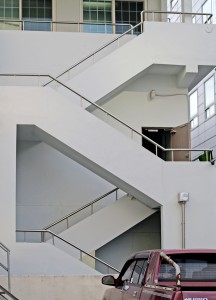
I was interested in its raison d’etre as a liminal space in between what is practically used and what is originally designed for, existing as a state of emergency that has yet to occur. Not to mention the fact that it is a space designed for vertical movements, I am intrigued by its calm representation of the probability of such actions. As I speculate further upon its brutalist aesthetics e.g. blunt concrete forms, parasite metal structure, ad hoc patches, etc. that is prevailed around the Guro factory buildings, I started to draw a scenario that led this kind of spacial adaptation in relation to the economic needs of the era. It might be a mimicry of Japanese architecture of the time that had conspicuous external stairs – I could still observe so many cases in Japan, that even led me to conceive a project about it in Tokyo. As Japanese heavy industry made great influence when developing the one in Korea during the 70′s, perhaps they followed similar paths in constructing infrastructure i.e. architectural condition that inhabited the dynamic of such business. Although it had left rather a low-fi version of what they mirrored.

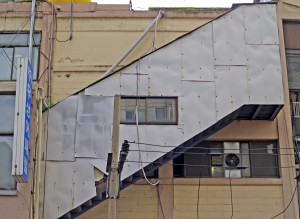

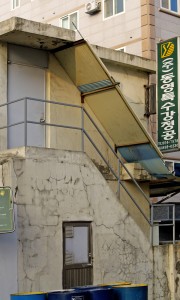
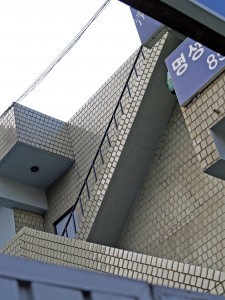
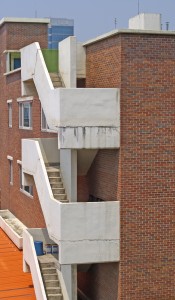
The external stairs started to hide inside the surface of buildings by the early 90′s. Thus the ones with external stairs also represent the state of building that is waiting for its death. Probably most of them are out in real estate auction.
This is work in progress, aiming at a rich taxonomy of architectural relics.
http://jihoilee.com
Posted: March 11th, 2010 | Author: nat | Filed under: architecture | No Comments »

The architect for Nam June Paik Art Center was selected among 430 participants in an international competition endorsed by the International Union of Artists (UIA) in 2003. The prize winning entry by Kirsten Schemel, a young German architect, who was commissioned together with Marina Stankovic in KSMS Schemel Stankovic Architects (Berlin) to design the building shown below. Characteristic of the museum is its screen facade consisting of several layers of reflective and partly printed glass. The building contains exhibition halls, video archive, multi-purpose hall, etc. The Nam June Paik Art Center has a total area of 5,600sqm (60,300sft) of which three stories are above ground and two stories underground. It was presented to the public at the completion ceremony on April 30, 2008
Text from http://www.njpartcenter.kr/
Posted: March 11th, 2010 | Author: nat | Filed under: architecture | No Comments »
Architectural Concept
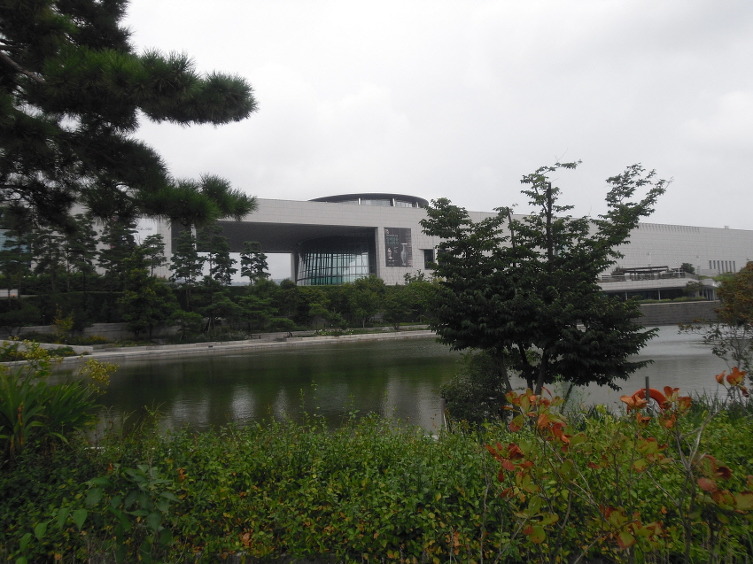
Modern Interpretation of Traditional Architecture
The basic concept of the new museum is to reinterpret traditional architectural spirit of Korea in a contemporary way. An open plaza is to connect two separate buildings and to make them appear as one grand building. The open plaza is designed to evoke maru (wooden floor), a unique architectural element in Korea. Open to all visitors, it serves as a gateway to all other points of the museum including the exhibition halls, special gallery, and the staff office.
With Mountains Behind and Water in Front
Mountains are an indispensable part of Korean environment. Mountains and water are elements of harmony and balance together like yin and yang, and generate prosperity and stability. In accordance with traditional architecture, the museum building is located deep inside from the boundary of the lot: the museum face south and has mountains behind and water in front.
Harmony between the Natural Park and the Cultural Complex
The pond in the center of the building site, the outdoor exhibition area, and the rest of the facilities are harmoniously arranged at the core of the museum architecture. The natural scenery of Yongsan Family Park provides a graceful setting for the museum building. Falls, streams, and green areas have been cultivated to create a useful and yet refined cultural space.
Disposition of Buildings with the Development of Central Axis of Seoul in Mind
A secondary gate has been planned at the northern site of the National Museum of Korea in preparation for the development of the Yongsan area, which will be part of the central axis of Seoul once the US military base is moved. The architectural plan has a symbolic significance as it will make the National Museum of Korea the center of the first museum complex in Korea.
Posted: March 11th, 2010 | Author: nat | Filed under: architecture | Tags: Moca | 1 Comment »
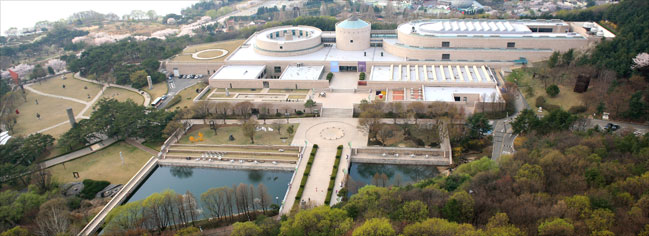
The museum building was constructed in a manner that harmonizes with both the natural and the artificial beauty of its surroundings, through a traditional form that invokes contemporary tastes.
The design of the museum reflects Korea’s traditional architectural style of fortress walls and a beacon mound. The museum features a sculpture gallery in the form of fortress walls, a painting gallery the shape of a semi-oval hall, and the Ramp Core in the style of a beacon mound that connects the two sections.
With the aim of providing a more consistent and convenient exhibition space, the Ramp Core is located at the center of the museum, and the sculpture exhibitions and painting exhibitions are positioned to the left and right of the Ramp Core. Visitors can reach each gallery by following the slanted slope of the Core.
The exterior space of the museum is designed to reflect a traditional Korean garden, enabling gradual access through a passage that gives the visual effect of a steady ascent. The sculpture garden is formed naturally by the shape of the surrounding land and the trees and shrubs.
The passageway, which starts from the south wall of the museum and navigates separately from the main road around the ravine, gives a sense of mysticism and calmness through the change in scenery and the hidden traditional houses.
The main exterior material is a light pink Korean granite, which is well-harmonized with the characteristics of the wooden material and the calm and stable form of the building. The museum has a traditional image that blends in well with the surrounding landscape. Fully equipped with modern facilities, scientific equipment and various installations, the museum is more than equal to the task of being the only national contemporary art museum in Korea.
Text from http://www.moca.go.kr/
Posted: March 10th, 2010 | Author: nat | Filed under: architecture | No Comments »
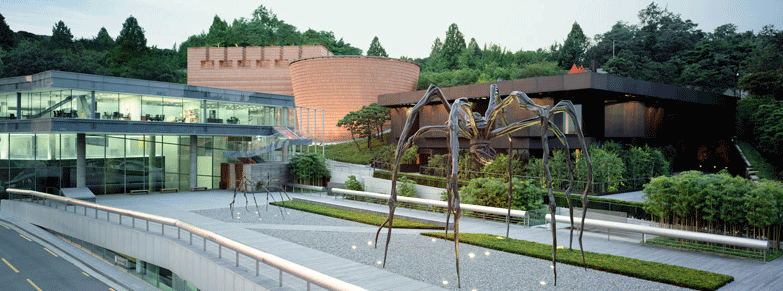
Leeum, Cultural Complex Designed by Three Architects of the World
Located on the slopes of the Namsan Mountain in Hannam-dong and flanked by the Hangang River, the Leeum complex is the optimal synthesis of nature and architecture. The complex is split into three major parts by three different internationally acclaimed architects. MUSEUM 1, which will house the Korean Traditional Art collection, has been designed by the Swiss architect, Mario Botta. MUSEUM 2, which is connected to MUSEUM 1, will house the Contemporary Art collection and has been designed by the French architect, Jean Nouvel. Along with Samsung Child Education & Culture Center by the Dutch architect Rem Koolhaas, these three works of contemporary architecture will create a cultural complex where these individual architectural masterpieces will be brought together to create a complementary and harmonious whole.
MUSEUM 1 for Korean Traditional Art and MUSEUM 2 for Contemporary Art collectively occupy a site of some 4,000 with a total floor area of 15,000. The Samsung Child Education & Culture Center, located at the entrance of Leeum, is sited in an area of 4,000 with a total floor area of 13,000. This Center will house educational facilities in the arts for children. Each of the three buildings will use a diverse material palette and innovative approaches to architectural design, reflecting the individuality of each of its designers. Their specific design contributions have created a unique cultural complex that will be an international architectural destination. Mario Bottas solid forms of terracotta, symbolizing earth and fire, bring together traditional and contemporary sensibilities. Jean Nouvels innovative use of glass and steel reflect a highly contemporary attitude and Rem Koolhaas black concrete structure, creates an abstract space and makes a bold statement about his future of architecture.
 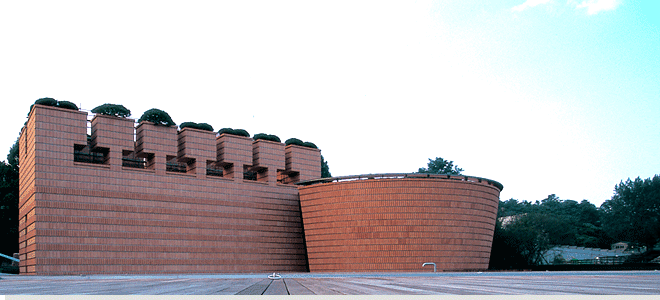
MUSEUM 1 Conveying Sublime Visual Capacity of Leeum

Mario Botta believes that museums should play a similar role to the religious buildings of the past. As houses of culture, he believes they should inspire solemnity and dignity.
MUSEUM 1 is a minimal but massive hexahedron & inverted cone on the slope of Namsan Mountain set against the backdrop of the Hangang River. This intersection of these powerful geometric volumes has symbolic value. The reverse cone mass marks a powerful threshold allowing people to enter underground crossing the southern road. The rooftop of the building evokes the battlements of old fortifications, taking us back to an image of ancient Seoul. Bottas building sits in stark contrast to the robust horizontal platform by Rem Koolhaas, which is also different from heavy mass by Jean Nouvel.
His proposal for stark and simple rectangular forms and reverse conical shapes produce a fortress-like quality, protecting the traditions that the museum houses. The exterior terracotta walls are a metaphor for Korean porcelain since both materials are created from earth and fire. The use of this material recalls traditional Korean earthenware, which constitutes many of the exhibition items. The respect for tradition is expressed by Botta distinctively with the geometrical symbolic volumes and stylized exterior wall at Leeum.
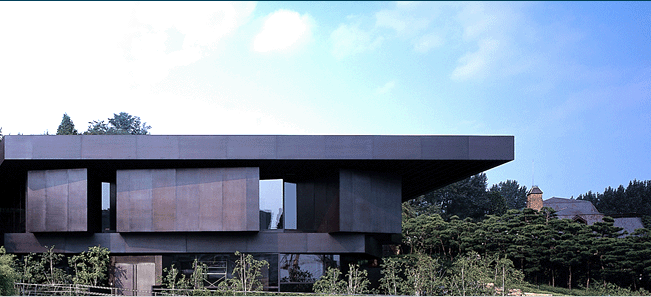 Â
Â
Sensuous Architecture Employing Progressive Technology and Materials

Jean Nouvels work is positioned at the intersection of state-of-the-art technological innovation and contemporary aesthetic practice, rendering his work both radical and provocative. Nouvel defines architecture as both ‘the technique of organizing space and the technique of creating an image. MUSEUM 2 of Leeum reflects his design philosophy.
MUSEUM 2 integrates itself into the natural landscape while remaining an autonomous contemporary art object in its own right. MUSEUM 2 for contemporary art collection is composed of rectangular ‘exhibition boxes’ of various sizes. These boxes are arranged in a seemingly loose manner to create a random-like arrangement, giving viewers a sense of surprise in each unique individual exhibition spaces. While programmatically well choreographed and highly organized the random-like arrangement of exhibition boxes gives the building an interesting form, which is integrated well with the site. MUSEUM 2 was designed to house the diverse collections of the Samsung Foundation of Culture. MUSEUM 2 will not only exhibit important works of Korean Modern artists but internationally renowned artists such as Donald Judd, Damien Hirst and Andy Warhol.
MUSEUM 2 contains conference facilities and office spaces in addition to the exhibition spaces. The viewers enter the MUSEUM 2 through the lobby of MUSEUM 1. The material for the exhibition boxes is rusted stainless steel, which is being used as building material for this project for the first time in the world. This new material, rusted stainless steal, has been researched through numerous testing processes, to ensure the process of natural rusting of the building over time will render the building itself to a progressive icon of contemporary art in an urban context.
Text from http://www.leeum.org/
Posted: March 10th, 2010 | Author: nat | Filed under: architecture | Tags: Rem Koolhaas & OMA moa | 1 Comment »
ARCHITECTURE

MoA(Museum of Art , Seoul National University), located beside the university’s main gate, serves as a contact point for the university and the local community. With U-glass exteriors and steel-framed trusses, the architecture of the MoA features a unique design that resembles a gigantic sculptural work floating in the air.
The interior of the MoA, with the floor area of 4,486.47 m2, consists of three stories and three underground levels. The dynamic spiral passage in the center connects the wings on two sides making the museum an open cultural space. The Museum’s entire structural design, the likes of which are rarely seen in Korea, organically connects exhibition spaces, educational spaces, and various other amenities like an archive room and a lounge.
â–ª Building Area: 2,775.56 m2
â–ª Gross Floor Area: 4,486.47 m2
â–ª Height: 17.575 m
â–ª Structure: Steel-framed trusses, ferroconcrete
â–ª Exterior finishing: U-Glass System
â–ª Designer: Rem Koolhaas
â–ª Supervisor: Office for Metropolitan Architecture (OMA), Samoo Architects & Engineers, Co., Ltd.
â–ª Builder: Architecture Division, Samsung Corporation
Rem Koolhaas & OMA : .
Creators of a new paradigm in urban structural design and architecture
Rem Koolhaas, the designer of the MoA, is an internationally renowned and influential architect not only in the field of modern architectural design but also in architectural theory. He took up architecture at the Architectural Association School of Architecture in London and worked for the Institute for Architecture and Urban Studies in New York. In addition, he wrote several seminal books on architectural theory, including Delirious New York (1978), which is considered a classic volume on modern and contemporary architecture and society. He was the recipient of the Pritzker Architecture Prize in 2000, often called the “Nobel Prize in Architecture.†The Office for Metropolitan Architecture (OMA), which he established in London in 1975, has its offices in Rotterdam, New York, and Beijing and is expanding its business not only in Europe but also in USA and Asia.
Some of his major designs include buildings such as the Netherlands Dance Theatre in the Hague, Kunsthal in Rotterdam, Los Angeles Museum, and Educatorium in Utrecht, as well as housing designs like the Nexus Housing in Fukuoka, Japan, Maison à Bordeaux in France, and The Dutch House in the Netherlands. His recent works are the Netherlands Embassy in Berlin and the Seattle Central Library in the USA. He also took charge of the expansion and the interior design for Prada stores in Manhattan, New York, and Los Angeles. He also participated in the design of Leeum, Samsung Museum of Art.
Professor in Practice of Architecture and Urban Design at Harvard University’s Graduate School of Design, Rem Koolhaas has been researching various issues that influence urban environments. His architectural design neither depends on any one trend nor advocates an identical style. In every design, his use of space is notably free, variable, and divided into various pieces depending on functions.
Text from  http://www.snumoa.org/
Posted: March 3rd, 2010 | Author: nat | Filed under: architecture | Tags: design, dongdaemun | No Comments »
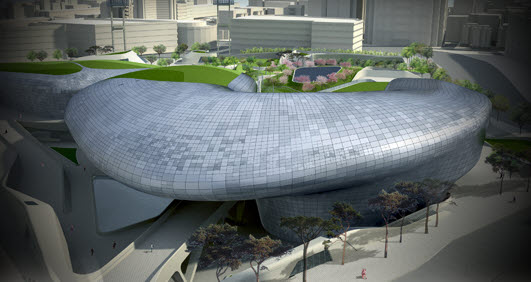
Design Plaza: comprehensive specialized facilities for the support of the design industry
- Covering an area of 83,000㎡ (including the underground cultural plaza), the Design Plaza will be equipped with a multi-purpose exhibition and convention hall, a design exhibition hall, an information training center, a learning center, a digital archive, a museum, and a design and media lab, as well as other facilities.
- The Design Plaza will be a global mecca for creative design by holding international design exhibitions and conferences, building a design network for cooperation at home and abroad, and running various support programs for creative design and marketing.
- It will host the Dongdaemun fashion industry by building and operating a fashion map and supporting marketing, production, and training.
- Development of an underground cultural plaza
The project will connect the trade area divided into the east and the west with Heunginmun-ro in the middle through the basement for the integration of the area and build an underground pedestrian network linked to the pedestrian underpass in Euljiro and subway stations of lines 2, 4, and 5, improving the pedestrian environment on the ground. Connected to the DDP structurally and functionally, the underground cultural plaza will serve as a high-class site for various cultural activities including exhibition and performance.
Text from  http://ddp.seoul.go.kr/eng/
Posted: March 3rd, 2010 | Author: nat | Filed under: architecture | Tags: architecture | No Comments »

Dominique Perrault completed the campus center for Ewha University in Seoul, Korea. The new ‘campus valley’ provides both Ewhaians and prospective female students with much-needed space for continuing education and student services.
Further project description after the break.
The center, which began with a design competition in 2004, includes standard programmatic elements such as classrooms, administrative offices, libraries and a cafeteria. Â The 20,000 square meter project also includes a unique commercial space, featuring a theater and retail stores.
As is customary of Perrault’s work, the campus center’s spaces are interspersed above and below the land, allowing the structure to explore the mingling of constructed material with earth. The campus center manages to fit into its contained site by submerging much of the spaces underground.  Light penetrates the structure through a large channel that sits between the building’s two halves.
The campus center is designed to offer a new sense of direction for higher education in the 21st century. Â It will establish organic relations between the building and surrounding areas of campus as well as between above ground and below ground spaces
Text from http://www.archdaily.com/23813/ewha-univeristys-campus-center-dominique-perrault/



















